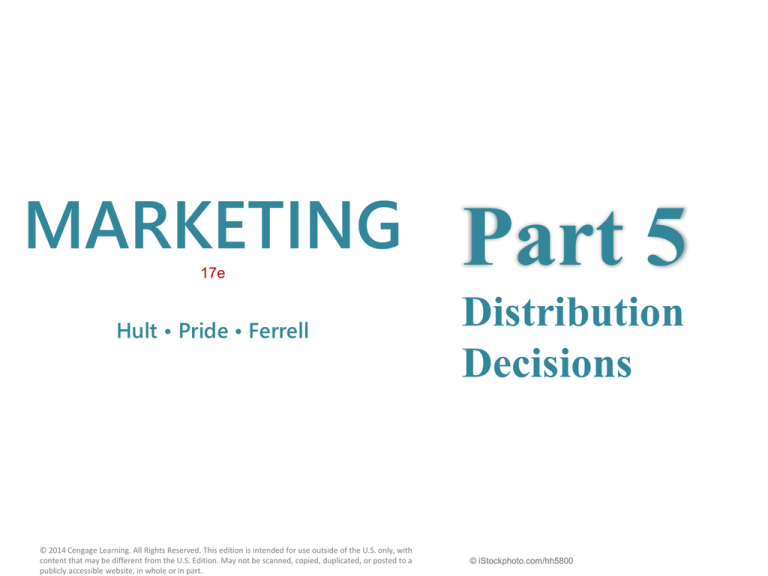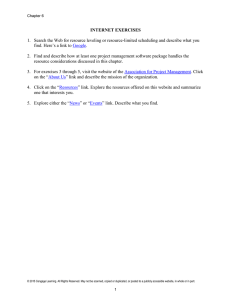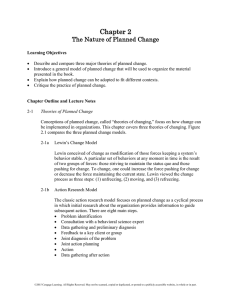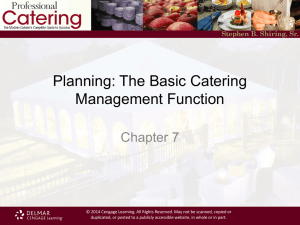
MARKETING
17e
Hult • Pride • Ferrell
© 2014 Cengage Learning. All Rights Reserved. This edition is intended for use outside of the U.S. only, with
content that may be different from the U.S. Edition. May not be scanned, copied, duplicated, or posted to a
publicly accessible website, in whole or in part.
Part 5
Distribution
Decisions
© iStockphoto.com/hh5800
14: Supply-Chain Management
and Marketing Channels
15: Retailing, Wholesaling, and
Direct Marketing
© 2014 Cengage Learning. All Rights Reserved. This edition is intended for use outside of the U.S. only, with
content that may be different from the U.S. Edition. May not be scanned, copied, duplicated, or posted to a
publicly accessible website, in whole or in part.
© iStockphoto.com/hh5800
15-2
Objectives
To describe the foundations of supply-chain
management
To explore the role and significance of marketing
channels and supply chains
To identify types of marketing channels
To understand factors that influence marketing channel
selection
To identify the intensity of market coverage
To examine strategic issues in marketing channels,
including leadership, cooperation, and conflict
To examine physical distribution as a part of supplychain management
To explore legal issues in channel management
© 2014 Cengage Learning. All Rights Reserved. This edition is intended for use outside of the U.S. only, with
content that may be different from the U.S. Edition. May not be scanned, copied, duplicated, or posted to a
publicly accessible website, in whole or in part.
© iStockphoto.com/hh5800
15-3
Foundations of the
Supply Chain
Distribution
The decisions and activities that make products
available to customers when and where they
want to purchase them
Supply Chain
All the activities associated with the flow and
transformation of product from raw materials
through to the end consumer
Operations Management
The total set of managerial activities used by an
organization to transform resource inputs into
products, services, or both
© 2014 Cengage Learning. All Rights Reserved. This edition is intended for use outside of the U.S. only, with
content that may be different from the U.S. Edition. May not be scanned, copied, duplicated, or posted to a
publicly accessible website, in whole or in part.
© iStockphoto.com/hh5800
15-4
Foundations of the
Supply Chain
Logistics Management
Planning, implementing and controlling the
efficient and effective flow and storage of
products and information from the point of
origin to consumption to meet customers’
needs and wants
Supply Management
The processes that enable the progress of
value from raw materials to final customer and
back to redesign and final disposition
© 2014 Cengage Learning. All Rights Reserved. This edition is intended for use outside of the U.S. only, with
content that may be different from the U.S. Edition. May not be scanned, copied, duplicated, or posted to a
publicly accessible website, in whole or in part.
© iStockphoto.com/hh5800
15-5
Supply-Chain Management
A set of approaches used to integrate the
functions of operations management, logistics
management, supply management and
marketing channel management so products are
produced and distributed in the right quantities,
the right locations and at the right time
The goal is to achieve optimal levels of
efficiency and service
The supply chain includes all entities that
facilitate product distribution and benefit from
cooperative efforts
© 2014 Cengage Learning. All Rights Reserved. This edition is intended for use outside of the U.S. only, with
content that may be different from the U.S. Edition. May not be scanned, copied, duplicated, or posted to a
publicly accessible website, in whole or in part.
© iStockphoto.com/hh5800
15-6
Key Tasks in Supply Chain
Management
© 2014 Cengage Learning. All Rights Reserved. This edition is intended for use outside of the U.S. only, with
content that may be different from the U.S. Edition. May not be scanned, copied, duplicated, or posted to a
publicly accessible website, in whole or in part.
© iStockphoto.com/hh5800
15-7
Supply Chain Management
Issues
Technology
Information technology has created almost
seamless distribution processes
Information sharing has reduced costs
Increased speed, flexibility, and cooperation
Technology has improved service
Increasing number of innovative goods
Increased involvement of firms in management
supply chain
Effective supply-chain management is closely
linked to a market orientation
© 2014 Cengage Learning. All Rights Reserved. This edition is intended for use outside of the U.S. only, with
content that may be different from the U.S. Edition. May not be scanned, copied, duplicated, or posted to a
publicly accessible website, in whole or in part.
© iStockphoto.com/hh5800
15-8
Role of Marketing Channels in
Supply Chains
Marketing Channel (Channel of Distribution,
Distribution Channel)
A group of individuals and organizations that
direct the flow of products from producers to
customers within the supply chain
Marketing Intermediaries
Middlemen that link producers to other
intermediaries or ultimate consumers through
contractual arrangement or through the
purchase and reselling of products
© 2014 Cengage Learning. All Rights Reserved. This edition is intended for use outside of the U.S. only, with
content that may be different from the U.S. Edition. May not be scanned, copied, duplicated, or posted to a
publicly accessible website, in whole or in part.
© iStockphoto.com/hh5800
15-9
Marketing Channel Activities
Performed by Intermediaries
© 2014 Cengage Learning. All Rights Reserved. This edition is intended for use outside of the U.S. only, with
content that may be different from the U.S. Edition. May not be scanned, copied, duplicated, or posted to a
publicly accessible website, in whole or in part.
© iStockphoto.com/hh5800
15-10
Discussion Point
Role of Marketing Channels
? How is the marketing
channel for premium
beef different from
the one for regular
beef?
? How can the
characteristics of a
marketing channel
influence customers’
perceptions of
products?
© 2014 Cengage Learning. All Rights Reserved. This edition is intended for use outside of the U.S. only, with
content that may be different from the U.S. Edition. May not be scanned, copied, duplicated, or posted to a
publicly accessible website, in whole or in part.
© iStockphoto.com/hh5800
15-11
The Significance of
Marketing Channels
Marketing channel decisions influence the
rest of the marketing mix
Channel decisions determine:
A product’s market presence
Buyer’s accessibility to the product
Effective marketing channels required for
organizational success
Entail long-term commitments among a
variety of firms
Difficult to change/undo marketing channel
decisions
© 2014 Cengage Learning. All Rights Reserved. This edition is intended for use outside of the U.S. only, with
content that may be different from the U.S. Edition. May not be scanned, copied, duplicated, or posted to a
publicly accessible website, in whole or in part.
© iStockphoto.com/hh5800
15-12
Marketing Channels
Create Utility
Time Utility – Having products available when
the customer wants them
Place Utility – Making products available in
locations where customers wish to purchase
them
Possession Utility – Customers have access to
the product to use now or store for future use
Form Utility – Formed by assembling,
preparing, or otherwise refining the product to
suit customer needs
© 2014 Cengage Learning. All Rights Reserved. This edition is intended for use outside of the U.S. only, with
content that may be different from the U.S. Edition. May not be scanned, copied, duplicated, or posted to a
publicly accessible website, in whole or in part.
© iStockphoto.com/hh5800
15-13
Marketing Channels Facilitate
Exchange Efficiencies
Marketing intermediaries can reduce the costs
of exchanges by performing certain services
or functions efficiently
Intermediaries are specialists in facilitating
exchanges
Access to and control over important resources
used in the proper functioning of marketing
channels
© 2014 Cengage Learning. All Rights Reserved. This edition is intended for use outside of the U.S. only, with
content that may be different from the U.S. Edition. May not be scanned, copied, duplicated, or posted to a
publicly accessible website, in whole or in part.
© iStockphoto.com/hh5800
15-14
Marketing Channels Facilitate
Exchange Efficiencies
Critics accuse wholesalers of being inefficient
and parasitic
While eliminating wholesalers may lower
customer prices it does not eliminate the need
for the services the wholesalers provide
© 2014 Cengage Learning. All Rights Reserved. This edition is intended for use outside of the U.S. only, with
content that may be different from the U.S. Edition. May not be scanned, copied, duplicated, or posted to a
publicly accessible website, in whole or in part.
© iStockphoto.com/hh5800
15-15
Efficiency in Exchanges
Provided by an Intermediary
© 2014 Cengage Learning. All Rights Reserved. This edition is intended for use outside of the U.S. only, with
content that may be different from the U.S. Edition. May not be scanned, copied, duplicated, or posted to a
publicly accessible website, in whole or in part.
© iStockphoto.com/hh5800
15-16
Typical Marketing Channels
for Consumer Products
© 2014 Cengage Learning. All Rights Reserved. This edition is intended for use outside of the U.S. only, with
content that may be different from the U.S. Edition. May not be scanned, copied, duplicated, or posted to a
publicly accessible website, in whole or in part.
© iStockphoto.com/hh5800
15-17
Channels for
Consumer Products
A long channel may be the most efficient
distribution channel for some consumer goods
When several channel intermediaries perform
specialized functions, cost may be lower than
when one channel member tries to perform
them all
Firms that specialize in certain elements of
producing a product or moving it through the
channel are more effective and efficient at
performing specialized tasks
Results in cost efficiencies and added value to
customers
© 2014 Cengage Learning. All Rights Reserved. This edition is intended for use outside of the U.S. only, with
content that may be different from the U.S. Edition. May not be scanned, copied, duplicated, or posted to a
publicly accessible website, in whole or in part.
© iStockphoto.com/hh5800
15-18
Typical Marketing Channels
for Business Products
© 2014 Cengage Learning. All Rights Reserved. This edition is intended for use outside of the U.S. only, with
content that may be different from the U.S. Edition. May not be scanned, copied, duplicated, or posted to a
publicly accessible website, in whole or in part.
© iStockphoto.com/hh5800
15-19
Channels for Business Products
Industrial Distributor
An independent business organization that
takes title to industrial products and carries
inventories
Usually sells standardized items, although
some carry a wide variety of items
Cost effective when a product has broad
market appeal, is easily stocked and serviced,
is sold in small quantities and is needed on
demand
© 2014 Cengage Learning. All Rights Reserved. This edition is intended for use outside of the U.S. only, with
content that may be different from the U.S. Edition. May not be scanned, copied, duplicated, or posted to a
publicly accessible website, in whole or in part.
© iStockphoto.com/hh5800
15-20
Channels for Business Products
Manufacturers’ Agent
An independent businessperson who sells
complementary products and is compensated
by commissions
• Does not acquire title or take possession
© 2014 Cengage Learning. All Rights Reserved. This edition is intended for use outside of the U.S. only, with
content that may be different from the U.S. Edition. May not be scanned, copied, duplicated, or posted to a
publicly accessible website, in whole or in part.
© iStockphoto.com/hh5800
15-21
Discussion Point
The Internet and smartphones have created
new distribution channels
Magazines and newspapers sell content via
smartphone and iPad apps
? How does this change the distribution system
for print media?
? From a marketers perspective, what are
potential problems with selling books,
magazines, and newspapers via apps?
© 2014 Cengage Learning. All Rights Reserved. This edition is intended for use outside of the U.S. only, with
content that may be different from the U.S. Edition. May not be scanned, copied, duplicated, or posted to a
publicly accessible website, in whole or in part.
© iStockphoto.com/hh5800
15-22
Multiple Marketing Channels
and Channel Alliances
Dual Distribution
The use of two or more marketing channels to
distribute the same products to the same
target market
Strategic Channel Alliance
An agreement whereby the products of one
organization are distributed through the
marketing channels of another
© 2014 Cengage Learning. All Rights Reserved. This edition is intended for use outside of the U.S. only, with
content that may be different from the U.S. Edition. May not be scanned, copied, duplicated, or posted to a
publicly accessible website, in whole or in part.
© iStockphoto.com/hh5800
15-23
Selecting Marketing Channels
© 2014 Cengage Learning. All Rights Reserved. This edition is intended for use outside of the U.S. only, with
content that may be different from the U.S. Edition. May not be scanned, copied, duplicated, or posted to a
publicly accessible website, in whole or in part.
© iStockphoto.com/hh5800
15-24
Selecting Marketing Channels
Customer Characteristics
Consumer market or business market?
Business customers often prefer to deal
directly with producers; are more likely to buy
complex products and in large quantities
Product Attributes
Complex/Expensive or standardized?
Durable or Fragile?
© 2014 Cengage Learning. All Rights Reserved. This edition is intended for use outside of the U.S. only, with
content that may be different from the U.S. Edition. May not be scanned, copied, duplicated, or posted to a
publicly accessible website, in whole or in part.
© iStockphoto.com/hh5800
15-25
Selecting Marketing Channels
Type of Organization
Large or small?
Large firms are often in a better position to
have more distribution centers, which reduce
delivery times
Smaller firms may be in a better position to
serve smaller-scale regional needs
Competition
High or low?
Highly competitive markets require companies
to keep costs and prices low
© 2014 Cengage Learning. All Rights Reserved. This edition is intended for use outside of the U.S. only, with
content that may be different from the U.S. Edition. May not be scanned, copied, duplicated, or posted to a
publicly accessible website, in whole or in part.
© iStockphoto.com/hh5800
15-26
Selecting Marketing Channels
Environmental Forces
Economic considerations will force
organizations to make compromises
Technology may help a firm modify/improve its
channel strategy
Government regulations and trade agreements
can affect channel strategy
Characteristics of Intermediaries
If an intermediary is not adequately promoting
an organization’s products, it may reconsider
channel choices
© 2014 Cengage Learning. All Rights Reserved. This edition is intended for use outside of the U.S. only, with
content that may be different from the U.S. Edition. May not be scanned, copied, duplicated, or posted to a
publicly accessible website, in whole or in part.
© iStockphoto.com/hh5800
15-27
Intensity of Market Coverage
Intensive Distribution
Uses all available outlets to distribute a
product
For most convenience products
Multiple channels may be used
Selective Distribution
Uses only some available outlets to distribute
a product
For shopping products
Desirable when a special effort is important to
customers
© 2014 Cengage Learning. All Rights Reserved. This edition is intended for use outside of the U.S. only, with
content that may be different from the U.S. Edition. May not be scanned, copied, duplicated, or posted to a
publicly accessible website, in whole or in part.
© iStockphoto.com/hh5800
15-28
Intensity of Market Coverage
Exclusive Distribution
Uses a single outlet in a fairly large geographic
area to distribute a product
For products purchased infrequently,
consumed over a long period of time, or
requiring service and information
Only authorized dealers are used
© 2014 Cengage Learning. All Rights Reserved. This edition is intended for use outside of the U.S. only, with
content that may be different from the U.S. Edition. May not be scanned, copied, duplicated, or posted to a
publicly accessible website, in whole or in part.
© iStockphoto.com/hh5800
15-29
Intensity of Market Coverage
© 2014 Cengage Learning. All Rights Reserved. This edition is intended for use outside of the U.S. only, with
content that may be different from the U.S. Edition. May not be scanned, copied, duplicated, or posted to a
publicly accessible website, in whole or in part.
© iStockphoto.com/hh5800
15-30
Discussion Point
? What intensity of coverage is most common
for the distribution of soft drinks? Shoes, like
Merrell?
© 2014 Cengage Learning. All Rights Reserved. This edition is intended for use outside of the U.S. only, with
content that may be different from the U.S. Edition. May not be scanned, copied, duplicated, or posted to a
publicly accessible website, in whole or in part.
© iStockphoto.com/hh5800
15-31
Strategic Issues in
Marketing Channels
Competitive
Priorities
Strategic Issues
Channel
Integration
© 2014 Cengage Learning. All Rights Reserved. This edition is intended for use outside of the U.S. only, with
content that may be different from the U.S. Edition. May not be scanned, copied, duplicated, or posted to a
publicly accessible website, in whole or in part.
Channel
Leadership,
Coordination, and
Conflict
© iStockphoto.com/hh5800
15-32
Competitive Priorities in
Marketing Channels
Supply chains can provide a competitive
advantage for many marketers
Supply chain decisions cut across all
functional areas of a business
An effective and efficient supply chain can
sustain a business in a variety of competitive
environments
Inefficient supply chains can lead to increased
costs
Integrated supply chains lead to a holistic view
of the supply chain
© 2014 Cengage Learning. All Rights Reserved. This edition is intended for use outside of the U.S. only, with
content that may be different from the U.S. Edition. May not be scanned, copied, duplicated, or posted to a
publicly accessible website, in whole or in part.
© iStockphoto.com/hh5800
15-33
Channel Leadership
Channel Captain (Channel Leader)
The dominant leader of a marketing channel or
a supply channel
May be a producer, wholesaler, or retailer
Channel Power
The ability of one channel member to influence
another channel member’s goal achievement
© 2014 Cengage Learning. All Rights Reserved. This edition is intended for use outside of the U.S. only, with
content that may be different from the U.S. Edition. May not be scanned, copied, duplicated, or posted to a
publicly accessible website, in whole or in part.
© iStockphoto.com/hh5800
15-34
Channel Cooperation
Cooperation is vital if each channel member is
to gain something from the others
Enables retailers, wholesalers, suppliers and
logistics providers to:
Speed up inventory replenishment
Improve customer service
Cut the costs of bringing products to customers
© 2014 Cengage Learning. All Rights Reserved. This edition is intended for use outside of the U.S. only, with
content that may be different from the U.S. Edition. May not be scanned, copied, duplicated, or posted to a
publicly accessible website, in whole or in part.
© iStockphoto.com/hh5800
15-35
Channel Cooperation
A marketing channel should be viewed as a
unified supply chain
Members should work toward common
objectives
Channel member tasks must be clearly
defined
© 2014 Cengage Learning. All Rights Reserved. This edition is intended for use outside of the U.S. only, with
content that may be different from the U.S. Edition. May not be scanned, copied, duplicated, or posted to a
publicly accessible website, in whole or in part.
© iStockphoto.com/hh5800
15-36
Channel Conflict
Channel conflict occurs when:
Self-interest creates misunderstanding about
role expectations of channel members
Communication is poor between channel
members
There is increased use of multiple channels
has increased the chance for
miscommunication and conflict
© 2014 Cengage Learning. All Rights Reserved. This edition is intended for use outside of the U.S. only, with
content that may be different from the U.S. Edition. May not be scanned, copied, duplicated, or posted to a
publicly accessible website, in whole or in part.
© iStockphoto.com/hh5800
15-37
Channel Integration
Vertical channel integration
Combines two or more stages of the marketing
channel under one management
Participants coordinated efforts to reach a
desired target market
Often effective against competition because of
increased bargaining power and shared
information and responsibilities
© 2014 Cengage Learning. All Rights Reserved. This edition is intended for use outside of the U.S. only, with
content that may be different from the U.S. Edition. May not be scanned, copied, duplicated, or posted to a
publicly accessible website, in whole or in part.
© iStockphoto.com/hh5800
15-38
Channel Integration
Vertical marketing systems (VMSs)
A single channel member coordinates or
manages channel activities to achieve low-cost
distribution aimed at satisfying target market
customers
Takes on corporate, administered, or
contractual forms
© 2014 Cengage Learning. All Rights Reserved. This edition is intended for use outside of the U.S. only, with
content that may be different from the U.S. Edition. May not be scanned, copied, duplicated, or posted to a
publicly accessible website, in whole or in part.
© iStockphoto.com/hh5800
15-39
Channel Integration
Horizontal channel integration
Combining organizations at the same level of
operation under one management
Creates economies of scale
Not the best method for improving distribution
Large size may decrease flexibility, increase
coordination problems and require additional
research and planning
© 2014 Cengage Learning. All Rights Reserved. This edition is intended for use outside of the U.S. only, with
content that may be different from the U.S. Edition. May not be scanned, copied, duplicated, or posted to a
publicly accessible website, in whole or in part.
© iStockphoto.com/hh5800
15-40
Physical Distribution in
Supply-Chain Management
Physical Distribution (Logistics)
Activities used to move products from
producers to consumers and other end users
Outsourcing
The contracting of physical distribution tasks to
third parties
Most distribution activities can be outsourced
to firms with expertise in specific areas
Cycle Time
The time needed to complete a process
© 2014 Cengage Learning. All Rights Reserved. This edition is intended for use outside of the U.S. only, with
content that may be different from the U.S. Edition. May not be scanned, copied, duplicated, or posted to a
publicly accessible website, in whole or in part.
© iStockphoto.com/hh5800
15-41
Goals of Physical Distribution
Right
Goods
Cycle
Time
Right
Support
System
Right
Place
Goals of
Physical
Distribution
Right
Quantity
© 2014 Cengage Learning. All Rights Reserved. This edition is intended for use outside of the U.S. only, with
content that may be different from the U.S. Edition. May not be scanned, copied, duplicated, or posted to a
publicly accessible website, in whole or in part.
Right
Price
Right
Time
© iStockphoto.com/hh5800
15-42
Proportional Cost of Each Physical Distribution
Function as a Percentage of Total Distribution Costs
© 2014 Cengage Learning. All Rights Reserved. This edition is intended for use outside of the U.S. only, with
content that may be different from the U.S. Edition. May not be scanned, copied, duplicated, or posted to a
publicly accessible website, in whole or in part.
© iStockphoto.com/hh5800
15-43
Order Processing
The receipt and transmission of sales order
information
Order Entry – Begins when customers place
orders
Order Handling – Product availability and customer
credit-worthiness is verified; order assembly
occurs
Order Delivery – Delivery is scheduled with carrier
Electronic Data Interchange (EDI)
A computerized means of integrating order
processing with production, inventory,
accounting, and transportation
© 2014 Cengage Learning. All Rights Reserved. This edition is intended for use outside of the U.S. only, with
content that may be different from the U.S. Edition. May not be scanned, copied, duplicated, or posted to a
publicly accessible website, in whole or in part.
© iStockphoto.com/hh5800
15-44
Inventory Management
Developing and maintaining adequate
assortments of products to meet customers’
needs
Stockouts – Shortages of products that can
result in loss of customers
Reorder point – The inventory level that signals
the need to place a new order
Order lead time – The average time lapse
between placing the order and receiving it
Usage rate – The rate at which inventory is
used/sold
Safety stock – The extra inventory a firm keeps
© 2014 Cengage Learning. All Rights Reserved. This edition is intended for use outside of the U.S. only, with
content that may be different from the U.S. Edition. May not be scanned, copied, duplicated, or posted to a
publicly accessible website, in whole or in part.
© iStockphoto.com/hh5800
15-45
Inventory Management
Reorder point =
(order lead time x usage rate) + safety stock
Just-in-Time (JIT)
An inventory-management approach in which
supplies arrive just when needed for
production or resale
© 2014 Cengage Learning. All Rights Reserved. This edition is intended for use outside of the U.S. only, with
content that may be different from the U.S. Edition. May not be scanned, copied, duplicated, or posted to a
publicly accessible website, in whole or in part.
© iStockphoto.com/hh5800
15-46
Materials Handling
Physical handling of tangible goods, supplies,
and resources
Also involves transportation from points of
production to points of consumption
Efficient materials handling can reduce costs,
the number of times a good is handled,
improve customer service and increase
customer satisfaction
Radio frequency identification (RFID) – Radio
waves are used to track materials using
scanners
© 2014 Cengage Learning. All Rights Reserved. This edition is intended for use outside of the U.S. only, with
content that may be different from the U.S. Edition. May not be scanned, copied, duplicated, or posted to a
publicly accessible website, in whole or in part.
© iStockphoto.com/hh5800
15-47
Warehousing
The design and operation of facilities for storing
and moving goods
Creates time utility
Helps stabilize prices and the availability of
seasonal items
The choice of warehouse is an important
strategic consideration
The correct warehouse can reduce
transportation and inventory costs and improve
customer service
© 2014 Cengage Learning. All Rights Reserved. This edition is intended for use outside of the U.S. only, with
content that may be different from the U.S. Edition. May not be scanned, copied, duplicated, or posted to a
publicly accessible website, in whole or in part.
© iStockphoto.com/hh5800
15-48
Types of Warehouses
Private Warehouses
Company-operated facilities for storing and
shipping products
Public Warehouses
Storage space and related physical distribution
facilities that can be leased by companies
Distribution Centers
Large, centralized warehouses that focus on
moving rather than storing goods
© 2014 Cengage Learning. All Rights Reserved. This edition is intended for use outside of the U.S. only, with
content that may be different from the U.S. Edition. May not be scanned, copied, duplicated, or posted to a
publicly accessible website, in whole or in part.
© iStockphoto.com/hh5800
15-49
Transportation
The movement of products from where they are
made to intermediaries and end users
The most expensive physical distribution function
Transportation
Mode
Railroads
Heavy, bulky freight; long distances over land
Trucks
The most flexible schedules and routes; more expensive
and vulnerable to weather; size and weight restrictions
Waterways
Cheapest method; heavy, low-value nonperishables;
markets must be accessible by water
Airways
Fastest and most expensive; high-value, low-bulk, or
perishable goods
Pipelines
Most automated; dependable; contents subject to shrinkage
© 2014 Cengage Learning. All Rights Reserved. This edition is intended for use outside of the U.S. only, with
content that may be different from the U.S. Edition. May not be scanned, copied, duplicated, or posted to a
publicly accessible website, in whole or in part.
© iStockphoto.com/hh5800
15-50
Characteristics and Ratings of
Transportation Modes by Selection Criteria
© 2014 Cengage Learning. All Rights Reserved. This edition is intended for use outside of the U.S. only, with
content that may be different from the U.S. Edition. May not be scanned, copied, duplicated, or posted to a
publicly accessible website, in whole or in part.
© iStockphoto.com/hh5800
15-51
Discussion Point
© 2014 Cengage Learning. All Rights Reserved. This edition is intended for use outside of the U.S. only, with
content that may be different from the U.S. Edition. May not be scanned, copied, duplicated, or posted to a
publicly accessible website, in whole or in part.
© iStockphoto.com/hh5800
15-52
Coordinating Transportation
Intermodal Transportation
Two or more transportation modes are used in
combination
Containerization:
Piggyback (truck and rail)
Fishyback (truck and water)
Birdyback (truck and air)
© 2014 Cengage Learning. All Rights Reserved. This edition is intended for use outside of the U.S. only, with
content that may be different from the U.S. Edition. May not be scanned, copied, duplicated, or posted to a
publicly accessible website, in whole or in part.
© iStockphoto.com/hh5800
15-53
Coordinating Transportation
Freight Forwarders
Organizations that consolidate shipments from
several firms into efficient lot sizes
Megacarriers
Freight transportation firms that provide
several modes of shipment
© 2014 Cengage Learning. All Rights Reserved. This edition is intended for use outside of the U.S. only, with
content that may be different from the U.S. Edition. May not be scanned, copied, duplicated, or posted to a
publicly accessible website, in whole or in part.
© iStockphoto.com/hh5800
15-54
Legal Issues in
Channel Management
Dual Distribution
Runs the risk of being viewed as anticompetitive
Restricted Sales Territories
Courts have conflicting opinions on restricting
intermediaries to certain sales territories
© 2014 Cengage Learning. All Rights Reserved. This edition is intended for use outside of the U.S. only, with
content that may be different from the U.S. Edition. May not be scanned, copied, duplicated, or posted to a
publicly accessible website, in whole or in part.
© iStockphoto.com/hh5800
15-55
Legal Issues in
Channel Management
Tying Agreement
A supplier furnishes a product to a channel
member with the stipulation that the channel
member purchases other products
Courts only accept tying agreements when the
supplier is the only one able to provide
products of a certain quality and the
intermediary can also carry competing
products
© 2014 Cengage Learning. All Rights Reserved. This edition is intended for use outside of the U.S. only, with
content that may be different from the U.S. Edition. May not be scanned, copied, duplicated, or posted to a
publicly accessible website, in whole or in part.
© iStockphoto.com/hh5800
15-56
Legal Issues in
Channel Management
Exclusive Dealing
A manufacturer forbids an intermediary to
carry products of competing manufacturers
Only considered legal if the deal blocks
competitors from less than 15% of the market,
the sales volume is small and the producer is
smaller than the retailer
© 2014 Cengage Learning. All Rights Reserved. This edition is intended for use outside of the U.S. only, with
content that may be different from the U.S. Edition. May not be scanned, copied, duplicated, or posted to a
publicly accessible website, in whole or in part.
© iStockphoto.com/hh5800
15-57
Legal Issues in
Channel Management
Refusal to Deal
Producers have the right to choose channel
members
Suppliers cannot legally refuse to deal with
wholesalers or dealers merely because these
wholesalers or dealers resist policies that are
anticompetitive or in restraint of trade
© 2014 Cengage Learning. All Rights Reserved. This edition is intended for use outside of the U.S. only, with
content that may be different from the U.S. Edition. May not be scanned, copied, duplicated, or posted to a
publicly accessible website, in whole or in part.
© iStockphoto.com/hh5800
15-58








